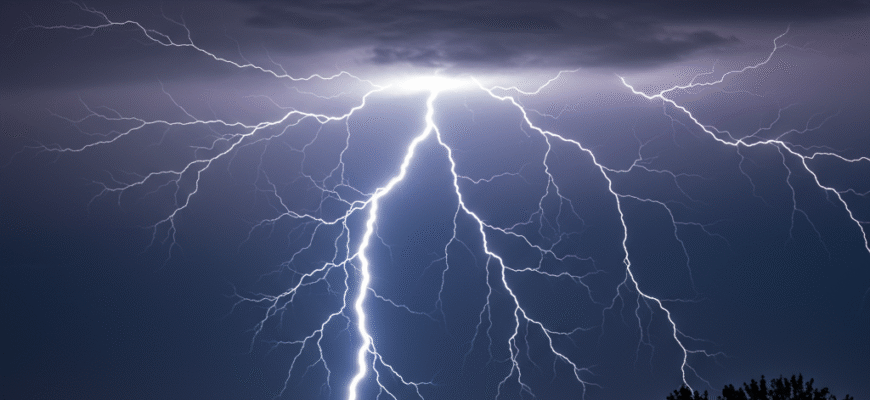Content
The Spark: What Lightning Does
Before we can understand thunder, we need a basic grasp of lightning. Lightning is essentially a giant electrical discharge, either between clouds or, more dramatically, between a cloud and the ground. This isn’t a gentle flow of electricity; it’s an incredibly powerful surge happening in a fraction of a second. The key factor for creating thunder is the immense heat generated by this electrical current as it rips through the air. The channel of air through which lightning passes is heated almost instantaneously to temperatures exceeding 50,000 degrees Fahrenheit (around 27,760 degrees Celsius). To put that in perspective, that’s roughly five times hotter than the surface of the sun!The Bang: Air Expanding Explosively
What happens when you heat air that rapidly and that intensely? It expands – explosively. Imagine heating a pocket of air to such extreme temperatures in less than a blink of an eye. The air molecules are energized beyond belief and violently push outwards, expanding at speeds faster than the speed of sound. This sudden, violent expansion of the air surrounding the lightning channel is the direct cause of thunder. Think of it like a super-fast, super-hot pressure wave blasting outwards from the path the lightning took. This isn’t a gentle puff; it’s a shockwave, a disturbance travelling through the air at supersonic speeds initially. This rapid expansion compresses the surrounding air, creating a wave front of high pressure.From Shockwave to Sound Wave
This initial shockwave is incredibly intense close to the lightning channel. However, like ripples in a pond, the shockwave spreads outwards in all directions from the lightning path. As it travels further away, it rapidly loses energy and slows down. Within a relatively short distance (perhaps tens of yards), the shockwave slows to below the speed of sound. It’s at this point that the shockwave transitions into what we perceive as an ordinary, albeit very loud, sound wave. This sound wave continues to travel through the air, eventually reaching our ears. And that is what we hear as thunder. So, thunder is the sound wave created by the rapid, heat-driven expansion of air along the path of a lightning bolt. It’s the audible evidence of that incredibly hot, incredibly fast event.Why the Delay? The Race Between Light and Sound
Now we understand what thunder is, but why do we see the lightning so much earlier? The answer lies in the fundamental difference between the speed of light and the speed of sound.- Light travels at an astonishing speed – approximately 186,282 miles per second (about 299,792 kilometers per second) in a vacuum, and nearly as fast through air. For any storm distance we experience on Earth, the light from the lightning flash reaches our eyes almost instantaneously.
- Sound, on the other hand, travels much more slowly through air. Its speed depends on factors like air temperature and humidity, but a typical value is around 1,125 feet per second (about 343 meters per second, or roughly 767 miles per hour).
Estimating the Distance
This predictable delay allows for a rough estimation of how far away the lightning struck. Because sound travels approximately one mile in five seconds (or one kilometer in about three seconds), you can count the seconds between seeing the flash and hearing the thunder.- Count the seconds.
- Divide the number of seconds by 5 to get an estimate in miles.
- Divide the number of seconds by 3 to get an estimate in kilometers.
Remember, the sound wave we call thunder is direct evidence of a recent lightning discharge. Hearing it means the event occurred in your relative vicinity, even if it seems delayed. Because sound travels significantly slower than light, the delay simply reflects the time sound needed to reach you, confirming the storm’s activity isn’t infinitely far away.
Why Does Thunder Sound Different? Cracks, Rumbles, and Rolls
Thunder isn’t always the same sound. Sometimes it’s a sharp, loud crack, other times a low, continuous rumble. Why the variation?Distance and Frequency
The primary factor is distance. Sound waves contain various frequencies. High-frequency sounds (which we perceive as sharp or crackling) dissipate more quickly in the atmosphere than low-frequency sounds (which we perceive as rumbles).- Close Lightning: If lightning strikes nearby, you hear the full range of frequencies almost simultaneously, including the high frequencies, resulting in a sharp, loud crack or bang. The sound wave hasn’t had much time or distance to travel, so less energy is lost.
- Distant Lightning: If lightning is far away, the high-frequency components of the sound wave are scattered and absorbed by the air, terrain, and atmospheric conditions more effectively. Only the lower frequencies travel the distance well, resulting in the characteristic low rumble.
Lightning Channel Shape and Length
Lightning doesn’t usually follow a straight line; it zig-zags and branches. Furthermore, a lightning channel can be miles long. Sound is generated along the entire length of this channel.- Rumbling Effect: Sound from different parts of the channel reaches your ear at slightly different times. Sound from the closest part of the channel arrives first, while sound from farther segments arrives later. This continuous arrival of sound waves from various points along the channel contributes to the rolling or rumbling effect.
- Multiple Booms: Sometimes distinct sections of the lightning channel heat the air almost simultaneously, creating multiple sound sources that might arrive as separate booms.
Atmospheric Effects
The atmosphere itself influences how thunder sounds.- Reflection and Refraction: Sound waves can bounce off hills, buildings, and different layers of air (temperature inversions). These echoes and refractions can prolong the sound, making it rumble for longer, or even cause sound from a distant strike to be heard more clearly than expected.
- Wind and Temperature Gradients: These factors can bend (refract) sound waves, affecting their path and how clearly they are heard at different locations.









